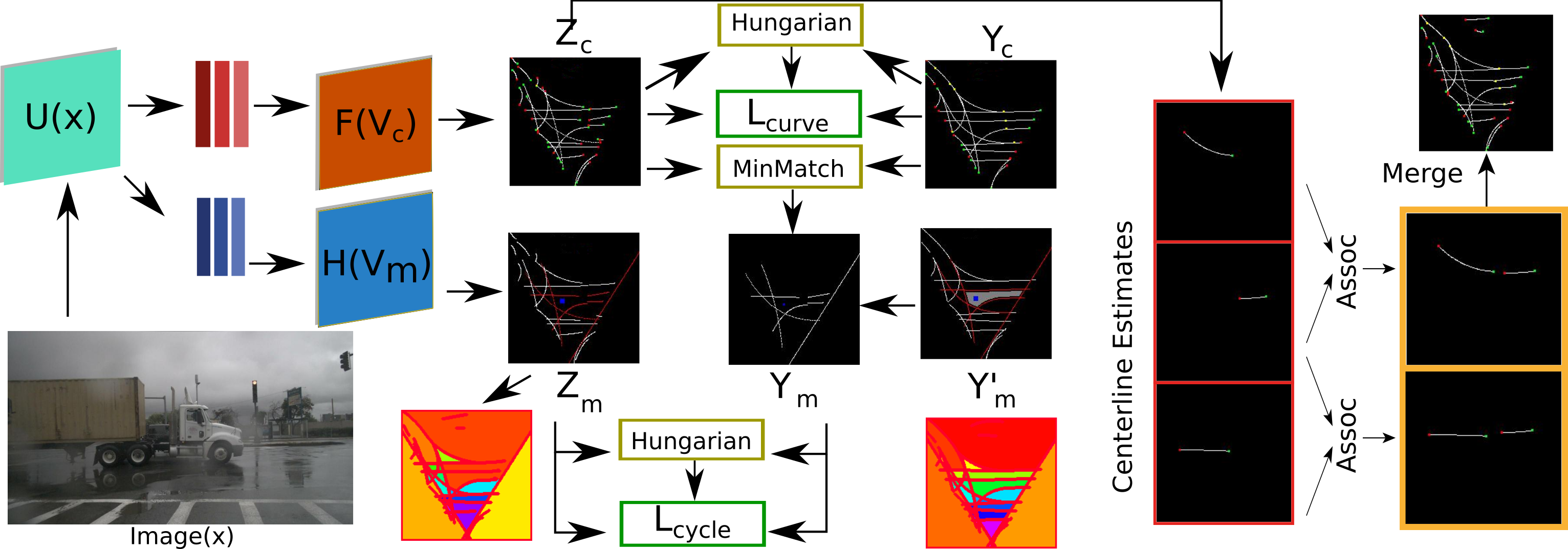Official code for "Topology Preserving Local Road Network Estimation from Single Onboard Camera Image" (CVPR 2022)
How would you give directions to a driver? One of the most intuitive ways is by stating turns, instead of distances. For example, taking the third right turn is more intuitive and robust than going straight for 100 meters and turn right. This observation motivates us to model road networks using the involved lanes and their intersections. Consider the example given in the figure. All 4 estimates (sub-figures (b) and (c)) have the same underlying directed graph. Now, consider a car moving from the green point P upwards in the figure, which needs to take the first left turn. In the two estimates of (b), the first left leads to different lanes (red and blue, respectively). Moreover, the first left in righthandside of (b) is not even a legal turn. Our proposed method is trained to preserve the topology of the road network. In (c), the first left turn is always the red curve. This is achieved by preserving the Minimal-Cycles. The cyan shaded region that exists in true lane graph, is preserved in our method. We show that, preserving these regions makes sure that the topology is preserved.
The overall method reconstructs the true minimal cycles in terms of the estiamted centerlines and uses these reconstructed minimal cycles as a supervision. This teaches the network the concept of closed cycles. Combined with the centerline (Bezier curve control points) supervision, this encourages topology preserving.
We provide support for Nuscenes and Argoverse datasets.
- Make sure you have installed Nuscenes and/or Argoverse devkits and datasets installed
- Set the paths in the relevant config .yml file in the configs folder
- Run the make_labels.py file for the dataset you want to use (Identical to STSU )
- Download the exracted Minimal-Cycles from the link below or extract them with poly_gt_saver.py. Noe that extraction of MCs take a lot of time. Thus, set the interval_start and interval_end options. The MCs for the scenes in the provided interval will be extracted and saved as npy file.
- You can use train_tr_nusc.py/train_tr_argo.py for training the transformer based model or train_prnn_nusc.py/train_prnn_argo.py to train the Polygon-RNN based model
- We recommend using the pretrained STSU model to warm start
- Validator files can be used for testing. The link to trained models are given below.
Nuscenes trained Polygon-RNN based model is at: https://data.vision.ee.ethz.ch/cany/TPLR/ckpts/PRNN_MC_Nusc.pth
Nuscenes trained Transformer based model is at: https://data.vision.ee.ethz.ch/cany/TPLR/ckpts/TR_MC_Nusc.pth
Argoverse trained Polygon-RNN based model is at: https://data.vision.ee.ethz.ch/cany/TPLR/ckpts/PRNN_MC_Argo.pth
Argoverse trained Transformer based model is at: https://data.vision.ee.ethz.ch/cany/TPLR/ckpts/TR_MC_Argo.pth
Nuscenes : https://data.vision.ee.ethz.ch/cany/TPLR/poly-dicts/nusc-polygon-dicts.zip
Argoverse : https://data.vision.ee.ethz.ch/cany/TPLR/poly-dicts/argo-polygon-dicts.zip
The implementation of the metrics can be found in src/utils/confusion.py. Please refer to the paper for explanations on the metrics.

